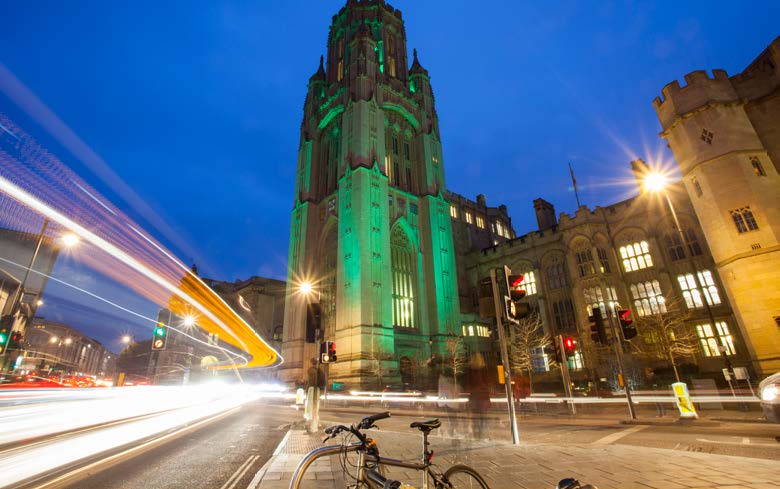Local Action for the Global Goals: A Case Study of Bristol
In 2019, Bristol was the first city in the UK to publish a Voluntary Local Review (VLR) to assess local progress in meeting the Sustainable Development Goals (SDGs). The 2022 report provides updated data and information about Bristol’s progress, examines how other UK cities have approached sustainable development – especially considering recent challenges – and reflects on how national government could better partner with local governments to deliver that development.
Foreword - APPG UN Global Goals
 Rt Hon Lord Jack McConnell
Chair, APPG UN Global Goals
|
Since 2015, the All Party Parliamentary Group on the UN Global Goals has championed the Sustainable Development Goals as the universal framework to leave no-one behind. However, delivering on the Global Goals is not only about our actions abroad, but also what we choose to do here at home.
EXECUTIVE SUMMARY
Bristol is a diverse, creative and internationally connected city in South West England with a strong commitment to sustainable development. The city and many of its organisations are committed to delivering the United Nations (UN) Sustainable Development Goals (SDGs).
In 2019, Bristol was the first city in the UK to publish a Voluntary Local Review to assess local progress in meeting the SDGs.
Bristol has achieved much progress since the last report. Some areas of education, particularly early years’ attainment and higher education, have seen improvements although due to the COVID pandemic not all data is recent. Since declaring a climate and ecological emergency in 2018, Bristol has made some important gains, with citywide carbon emissions falling every year and the share of renewables in Bristol’s energy mix growing. Progress against economic growth measures is harder to determine given the impact of COVID-19 on data collection. However, unemployment rates have generally fallen, earnings for men and women have increased and the pay gap between men and women has decreased.
Unfortunately, progress against other measures has been less advanced. There are a growing number of children under 16 living in low-income families. According to our analysis, violent and sexual crime, domestic abuse, fear of crime and mental health issues have also risen. An increasing number of households are using food banks, with wards on the edges of the city boundaries most severely impacted.
Bristol’s One City Plan is an example of how collaborative, cross-sectoral approaches can help achieve the SDGs.
Some indicators were missing due to a lack of reporting during the pandemic on issues like education results and public transport usage, and the COVID-19 pandemic clearly impacted others results, such as community engagement with green spaces.
The growing engagement and adoption of the SDGs at a local level in the UK has occurred while local authorities (LAs) have faced smaller budgets and growing needs. For the past decade and through the pandemic and now an escalating cost-of-living crisis, LAs have been asked to maintain services while spending less and less money. But the financial challenges go far beyond shrinking local budgets. The many short-term, competitive funding mechanisms that LAs increasingly rely upon undermine long-term financial planning and take up time and effort that could be devoted to delivering services rather than fundraising undermining local stability.
It was in this context that Bristol’s localised approach to sustainable development emerged, and the strong partnerships that have formed between public, private, civil society organisations, unions and academia have been crucial in delivering the SDGs: Bristol’s One City Plan is an example of how collaborative, cross-sectoral approaches can help achieve them.
Looking forward, establishing a more stable financial environment for local authorities, deepening devolution, resourcing partnership coordinators, supporting community action and investing in national and international collaborations would all help amplify local action to address our shared global challenges.

Foreword - VLR Report 2022
 Marvin Rees
Mayor of Bristol
|
 Professor Evelyn Welch
Vice-Chancellor, University of Bristol
|
In 2019, Bristol was the first UK city to produce a Voluntary Local Review of progress towards the UN Sustainable Development Goals (SDGs). These goals reflect a holistic view of sustainability, recognising the importance of reducing our collective impact on the planet while tackling poverty and addressing entrenched inequalities within and between nations.
CHALLENGES AND OPPORTUNITIES FOR LOCAL ACTION
Bristol faces several financial and institutional challenges, that are also shared by other UK local authorities, in its ambition to accelerate local action in pursuit of sustainable development. The city has responded innovatively to these challenges through initiatives such as the One City model, Bristol City Funds and collaborative efforts to improve data sharing and integration.
Challenges:
|
Opportunities:
|
PIECEMEAL DEVOLUTION
Bristol’s first Voluntary Local Review highlighted the challenge of jurisdictional complexity. It is often the case that the functional urban areas of UK cities do not correspond with local authority boundaries. In Bristol, for example, the City Council local authority area only contains about 70% of the total population of the Bristol Built-Up Area and less than half of the city-region population of 1.1 million. But critical social, economic and environmental challenges do not disappear at the edge of local authority borders. Flows of people, goods, money and pollution cross the council borders daily. The local authorities within the city region are interdependent with one another.
While the devolution deals that brought about mayoral combined authorities have brought new local powers in adult education, transport and housing, they have been criticised for not going far enough.
There are also complexities brought about by the newly forming Integrated Care Systems (ICS). Across England, these systems are being developed jointly by local authorities and the NHS. While many local authorities consulted for this report appreciate this new approach to meaningful devolution, smaller or less proactive local authorities stand to lose out considerably if they are unable to participate in the consultations being carried out as these regional healthcare bodies form. In the case of Bristol, the local authority is one of three in a single system. The Bristol Health and Wellbeing Board acts as an effective bridge between local authorities and the ICS, whereas the formation of the Kent and Medway ICS demands the engagement of 26 borough councils. Conversely, Cornwall County Council has just one council and one ICS, making it far easier for the local government to align its priorities with the ICS as it develops. This contrast between different systems will make it harder for some local authorities to focus on tackling issues of health and, consequently, the SDG agenda. Engaging meaningfully with the ICS formation process requires capacity within local authorities, which has become more difficult to resource post-COVID in the face of significant financial pressures, exacerbated by COVID and the requirement workforce pressures.
In sum, devolution has been piecemeal, undermining coherent and ambitious local and regional action. These challenges have been significantly compounded by fiscal constraints.

AN UNSTABLE FISCAL CONTEXT
Finance is a critical barrier to accelerated local action. Since the introduction of a programme of austerity beginning in 2009, local authorities have been in a persistent state of fiscal triage. The Ministry of Housing, Communities & Local Government (now known as the Department for Levelling Up, Housing and Communities) estimates that national funding for local authorities fell by 49.1% in real terms between 2011 and 2018. As the austerity programme was spatially blind to the varying socio-economic conditions of each local authority, its effects have been experienced unevenly. Cities in the North were particularly affected by the cuts, with Newcastle City Council currently facing a £94 million spending gap in addition to the £305 million reduction in their budget since 2010.
Immediate social and economic issues are prioritised over longer-range challenges, including sustainable development.
Increased funding for local government will be essential to accelerate sustainable development.
However, limited funding is not the only fiscal challenge. Our research revealed widespread frustration with the way critical resources – particularly for investment – are allocated through competitive, time-bound and ringfenced funding mechanisms. Councils are required to bid for funding from Westminster or negotiate a deal to address critical local priorities, which one policy officer deemed a “waste of time and resources,”especially for unsuccessful bids and negotiations The increasing reliance on “bidding and deal-making rather than capacity building” for local government in the UK undermines the strategic planning that sustainable local development demands.
For example, in 2017, Bristol was awarded funding from Feeding Britain for Feeding Bristol, a pilot to tackle food poverty in the city. However, the city was unsuccessful in its follow-up bid and the project paused. Eventually new funding was secured, but the fundraising activity itself diverted valuable resource from getting on with the work. This model of competitive funding also means that successful pots of funding for one local authority come at the detriment of others, exacerbating regional inequalities. Under-resourced authorities grappling with protracted austerity have simply been unable to access certain funding opportunities due to capacity constraints (ibid). Such inequalities are compounded by universal reductions in grant funding. Consequently, many of the most deprived local authorities, which relied more heavily on grant funding, faced greater reductions, resulting in local authority budgetary changes ranging from –1.6% to –46% (Gray and Bradford, 2018).

This model of competitive funding also means that successful pots of funding for one local authority come at the detriment of others, exacerbating regional inequalities.
Funding mechanisms are also often ringfenced for particular types of investment, or service improvements dictated by central government, rather than driven by locally defined priorities. For example, the recent Household Support Fund ringfenced spending percentages such that a proportion of the funding had to spent on pensioners. While not an issue in itself, the funding allocations created complexity. By ringfencing the funds to be spent on pensioners receiving Pension Credit, the local demographics were not considered. In Greater Bristol, falling within the administrative boundary of the West of England Combined Authority, fewer pensioners claim Pension Credit than in many surrounding local authorities. As a result, Bristol’s pensioners received disproportionately more funding per person than pensioners in surrounding local areas. It also meant that other vulnerable groups in Bristol received a lower level of support than they would have if the local authority had been able to choose how the finance was spent.
The need for further devolution and increasing council capacity to raise finances independently of Westminster were repeated themes when speaking to council policy leads. Representatives from the Core Cities also stressed the importance of building private-public partnerships.
- In Glasgow, the SDGs were seen as a key hook for engaging businesses in positive social and environmental action – a message that resonates with Bristol’s experience.
- Similarly, Newcastle shared its commitment to increasing stakeholder engagement, while Belfast is also investigating the opportunities presented by public-private partnerships to deliver its SDG-related ambitions.
Funding mechanisms are also often ringfenced for particular types of investment, or service improvements dictated by central government, rather than driven by locally defined priorities.
The need for further devolution and increasing council capacity to raise finances independently of Westminster were repeated themes when speaking to council policy leads.
Giving local authorities greater autonomy over how regional finance is spent and providing longer-term, less competitive sources of funding would allow local authorities to better target their work to support the most vulnerable. It would also allow for better recognition of the specific challenges of each local authority and improve equity of funding for areas across the UK that face the greatest deprivation.

CITY LEAP
A ground breaking initiative to transform Bristol’s energy infrastructure
The City Leap partnership is a new approach to providing low-carbon infrastructure for a city. Bristol City Council has partnered with Ameresco and Vattenfall to leverage over £1billion of investment in the city’s low-carbon infrastructure across 20 years As part of this commitment, Vattenfall and Ameresco will help deliver district heat networks and retrofit the city’s social housing stock. During the first five years of the twenty-year partnership, the private sector will invest at least £424 million in a range of large infrastructure projects to reduce Bristol’s carbon footprint by 140,000 tonnes.
DATA DEFICITS
Access to the data required to report on the SDGs remains problematic. Local authorities in the UK are fortunate to have support from the Office for National Statistics (ONS), but not all relevant data is held by the ONS. Some government departments do not share data or do not geographically disaggregate data to the level required for local monitoring. A lack of disaggregated data, or a lack of access to data, can make targeted interventions by local authorities difficult to justify, deliver and monitor. This is particularly true for issues around biodiversity where a lack of concrete data for most local authorities and a lack of resourcing to record new data makes it difficult to target action.

Addressing data deficits and mapping local data onto the SDG monitoring framework across UK local authorities could enhance intercity communication, coordination and the monitoring of progress.
THE POWER OF PARTNERSHIP COORDINATORS

COMMUNITY CLIMATE ACTION PLANS
MOVING FORWARD
- Belfast City Council described the pandemic as a ‘reset moment’ for the city with hopes that priorities can be reassessed to guarantee a future in which no one is left behind.
- A representative from Glasgow City Council highlighted improvements made to active travel infrastructure using COVID-response funding.
- Over the next three years,Liverpool City Council has pledged £10 million to make the city greener by investing in parks and green spaces, with £3 million set aside for retrofitting public buses to reduce nitrogen dioxide levels and air pollution in congested areas of the city.
- In Nottingham, local councillors found that the reduction of mowing during lockdown helped change attitudes to rewilding. Greater numbers of wildflowers and more natural green spaces showed citizens the benefits of protecting biodiversity.
- An innovative partnership in Bristol, City Leap, will provide low-carbon infrastructure for the city.
The covid crisis has propelled innovation through cross-sectoral collaborations and laid the foundations for long-term change.
- In Bristol, many communities organised food deliveries, prescription pick-ups and neighbourhood befriending. These groups serve as critical social infrastructure, often filling gaps in local authority and voluntary, community and social enterprise provision.
- The Community Champions scheme introduced in Newcastle in response to COVID has focused on improving community education on healthcare and mitigating lower vaccine uptake in some demographic groups.
The empowerment of communities, local organisations and city governments is essential to accelerate progress. This can be achieved by devolving more powers, simplifying devolved structures, providing a stable funding environment and facilitating local partnerships. Finally, greater awareness and alignment with the UN’s SDG framework among Core Cities could improve intercity coordination and generate productive dialogue on shared challenges that inspires creative solutions.

